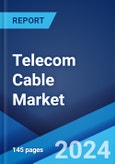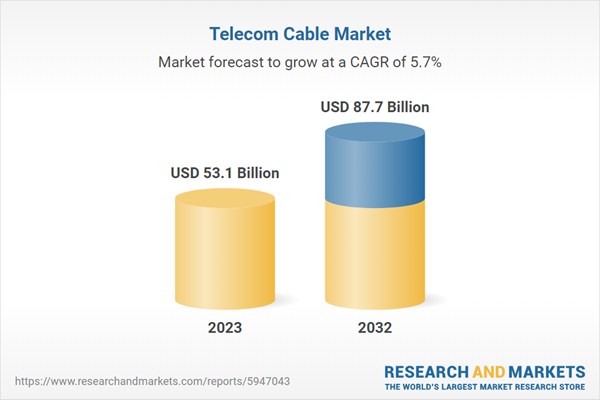The global telecom cable market size reached US$ 53.1 Billion in 2023. Looking forward, the publisher expects the market to reach US$ 87.7 Billion by 2032, exhibiting a growth rate (CAGR) of 5.7% during 2023-2032. Increasing demand for high-speed and reliable connectivity, growing adoption of smart devices and the Internet of Things (IoT), rapid expansion of the telecommunications industry, and the surging adoption of cloud computing services represent some of the key factors driving the market.
Telecom cables enable the seamless transmission of data and communication across vast distances. They are engineered to connect various telecommunication networks, including telephone lines, internet services, and television signals. A typical telecom cable consists of several components, such as conductive wires, insulation material, protective sheaths, and connectors. Conductive wires, usually made of copper or fiber optics, carry electrical or optical signals. They are enclosed in insulation material, which prevents signal interference and loss. The protective sheaths safeguard the cables from external damage, such as moisture, heat, and physical stress. Telecom cables offer several advantages, including high bandwidth capacity, low signal loss, and long-distance connectivity. They provide reliable and efficient transmission of voice, data, and video signals. Currently, there are different types of telecom cables available, including coaxial cables, twisted pair cables, and fiber optic cables. Coaxial cables are primarily used for television and broadband internet connections, while twisted pair cables are utilized for telephone lines. Fiber optic cables, known for their high-speed transmission capabilities, use thin strands of glass or plastic to transmit data as pulses of light.
Telecom cables enable the seamless transmission of data and communication across vast distances. They are engineered to connect various telecommunication networks, including telephone lines, internet services, and television signals. A typical telecom cable consists of several components, such as conductive wires, insulation material, protective sheaths, and connectors. Conductive wires, usually made of copper or fiber optics, carry electrical or optical signals. They are enclosed in insulation material, which prevents signal interference and loss. The protective sheaths safeguard the cables from external damage, such as moisture, heat, and physical stress. Telecom cables offer several advantages, including high bandwidth capacity, low signal loss, and long-distance connectivity. They provide reliable and efficient transmission of voice, data, and video signals. Currently, there are different types of telecom cables available, including coaxial cables, twisted pair cables, and fiber optic cables. Coaxial cables are primarily used for television and broadband internet connections, while twisted pair cables are utilized for telephone lines. Fiber optic cables, known for their high-speed transmission capabilities, use thin strands of glass or plastic to transmit data as pulses of light.
Telecom Cable Market Trends:
The increasing demand for high-speed and reliable connectivity, the rising penetration of smartphones, and the growing adoption of smart devices and the Internet of Things (IoT) are some of the key factors propelling the market growth. Moreover, the rapid expansion of the telecommunications industry and the surging adoption of cloud computing services are other growth-inducing factors. Besides this, the rising popularity of video streaming platforms and the ongoing deployment of 5G networks are fueling the market growth. Additionally, governments of various nations are undertaking initiatives to promote digitalization and broadband connectivity, which is providing an impetus to the market growth. Furthermore, continuous advancements in telecom cable technology, such as improved fiber optic cable designs and higher transmission speeds, and the rising awareness about energy-efficient solutions are accelerating the market growth. In line with this, the implementation of stringent regulations related to carbon emissions has led to the development of eco-friendly and sustainable telecom cable solutions, further augmenting the market growth.Key Market Segmentation:
The publisher provides an analysis of the key trends in each segment of the global telecom cable market, along with forecasts at the global, regional, and country levels from 2024-2032. The report has categorized the market based on type and application.Type Insights:
- Coaxial Cable
- Fiber Optic
- Data Center Cables
- Mobile Networks
- Twisted Pair Cable
- LAN Cables
Application Insights:
- Telecommunication
- Data Centers
- CATV
- Computer Network
- Others
Regional Insights:
- North America
- United States
- Canada
- Asia Pacific
- China
- Japan
- India
- South Korea
- Australia
- Indonesia
- Others
- Europe
- Germany
- France
- United Kingdom
- Italy
- Spain
- Russia
- Others
- Latin America
- Brazil
- Mexico
- Others
- Middle East and Africa
Competitive Landscape:
The report has also provided a comprehensive analysis of the competitive landscape in the global telecom cable market. Detailed profiles of all major companies have been provided. Some of the companies covered include Belden Incorporated, Commscope Holding Company Inc., Fujikura Ltd., Furukawa Electric Co. Ltd., Hengtong Group Co. Ltd., LS Cable & System Ltd. (LS Group), Nexans S.A., Proterial Cable America Inc., Prysmian S.p.A., Sumitomo Electric Industries Ltd., etc. Kindly note that this only represents a partial list of companies, and the complete list has been provided in the report.Key Questions Answered in This Report:
- How has the global telecom cable market performed so far, and how will it perform in the coming years?
- What are the drivers, restraints, and opportunities in the global telecom cable market?
- What is the impact of each driver, restraint, and opportunity on the global telecom cable market?
- What are the key regional markets?
- Which countries represent the most attractive telecom cable market?
- What is the breakup of the market based on the type?
- Which is the most attractive type in the telecom cable market?
- What is the breakup of the market based on the application?
- Which is the most attractive application in the telecom cable market?
- What is the competitive structure of the global telecom cable market?
- Who are the key players/companies in the global telecom cable market?
Table of Contents
1 Preface3 Executive Summary10 Value Chain Analysis12 Price Analysis
2 Scope and Methodology
4 Introduction
5 Global Telecom Cable Market
6 Market Breakup by Type
7 Market Breakup by Application
8 Market Breakup by Region
9 Drivers, Restraints, and Opportunities
11 Porters Five Forces Analysis
13 Competitive Landscape
List of Figures
List of Tables
Companies Mentioned
- Belden Incorporated
- Commscope Holding Company Inc.
- Fujikura Ltd.
- Furukawa Electric Co. Ltd.
- Hengtong Group Co. Ltd.
- LS Cable & System Ltd. (LS Group)
- Nexans S.A.
- Proterial Cable America Inc.
- Prysmian S.p.A.
- Sumitomo Electric Industries Ltd.
Methodology

LOADING...
Table Information
| Report Attribute | Details |
|---|---|
| No. of Pages | 145 |
| Published | March 2024 |
| Forecast Period | 2023 - 2032 |
| Estimated Market Value ( USD | $ 53.1 Billion |
| Forecasted Market Value ( USD | $ 87.7 Billion |
| Compound Annual Growth Rate | 5.7% |
| Regions Covered | Global |
| No. of Companies Mentioned | 10 |









